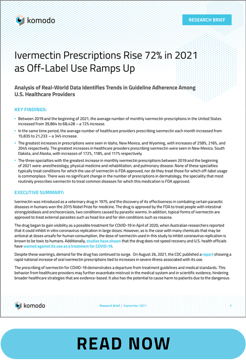When Guidelines Aren’t Followed: Healthcare Providers and Ivermectin

 Ivermectin has been called “the wonder drug.” Originating in the 1970s from soil-dwelling microorganisms isolated in a Japanese lab, it was first used in animals before it went on to win the Nobel Prize in Medicine in 2015 for its effectiveness against parasitic infections in humans. Ivermectin has shown promise for broader antimicrobial effects, including against many bacteria as well as viruses. But, like many potential treatments, it can be toxic at certain doses, and could do more harm than good when used in certain treatment regimes – the same reasons high-quality clinical trials are necessary to validate the safety and efficacy of any medication before rollout to the public. Today ivermectin is back in the news, being used against the recommendations of the FDA, CDC, and NIH with the intention to prevent and treat COVID-19.
Ivermectin has been called “the wonder drug.” Originating in the 1970s from soil-dwelling microorganisms isolated in a Japanese lab, it was first used in animals before it went on to win the Nobel Prize in Medicine in 2015 for its effectiveness against parasitic infections in humans. Ivermectin has shown promise for broader antimicrobial effects, including against many bacteria as well as viruses. But, like many potential treatments, it can be toxic at certain doses, and could do more harm than good when used in certain treatment regimes – the same reasons high-quality clinical trials are necessary to validate the safety and efficacy of any medication before rollout to the public. Today ivermectin is back in the news, being used against the recommendations of the FDA, CDC, and NIH with the intention to prevent and treat COVID-19.
Existing clinical trials have not found human-appropriate doses of ivermectin to be any better than a placebo for COVID-19 treatment and have not established its safety for that use. While a 2020 review published in Nature highlighted the theoretical potential for antiviral effects of ivermectin on RNA viruses, this theory is based mainly on findings from animal studies. The authors assert that human clinical trials are necessary to explore what are currently just hypotheses. Another oft-cited study, published last year in the journal Antiviral Research, found that the drug inhibited replication of SARS-CoV-2 in vitro. But, as reiterated in the NIH’s COVID-19 treatment guidelines, pharmacological studies suggest that doses “up to 100-fold higher than those approved for use in humans” may be necessary to reach plasma concentrations for antiviral action as effective as what was seen in the lab’s cell cultures. Researchers are calling for larger, high-quality studies.
Meanwhile, people across the United States are poisoning themselves. According to a recent CDC health advisory, poison control centers across the U.S. received a threefold increase in the number of calls for ivermectin poisoning in 2021. The number of related emergency room visits also rose, likely due to ingestion of higher-than-prescribed doses of the drug. Side effects of ivermectin toxicity can range from vomiting and blurred vision to seizure, coma, and death.
With insufficient data to establish the efficacy or safety of ivermectin's use for COVID-19, the CDC’s official recommendation to clinicians is clear: to “be aware that ivermectin is not currently authorized or approved by FDA for treatment of COVID-19” and to “educate patients and the public to get vaccinated against COVID-19." Despite this, a recent rise in the number of ivermectin prescriptions has been observed, outlined in an August report by the CDC’s Health Alert Network. We’ve followed up that report using the robust claims data in Komodo’s Healthcare Map™ to look at where, exactly, these prescriptions are being written, how often, and by whom.
The following are highlights from Komodo Health’s report on ivermectin prescription trends:
- The number of ivermectin prescriptions increased by 72% during the pandemic. Changes in ivermectin prescriptions varied significantly by state, with the greatest increases seen in Idaho, New Mexico, and Wyoming. In these states, the number of prescriptions increased by 258%, 216%, and 204%, respectively, between the pre-pandemic period of 2019 and the beginning of 2021. Idaho, for example, had an average of 116 prescriptions per month in 2019, which increased to 417 prescriptions per month in 2021.
- In the same time period, the average number of healthcare providers prescribing ivermectin each month increased by 34%. New Mexico, South Dakota, and Alaska saw the greatest increases, of 172%, 118%, and 117%, respectively.
- The provider specialties with the greatest increases in monthly ivermectin prescriptions are not those that typically treat conditions for which ivermectin use is approved: the three specialties with the greatest increases were anesthesiology, physical medicine and rehabilitation, and pulmonary disease. These specialties saw increases of 1,319%, 1,301%, and 1,167%, respectively.
This analysis confirms a concerning departure from treatment guidelines and medical standards. As there are existing therapies that are approved and evidenced to work in the prevention and treatment of COVID-19, this trend in behavior from medical providers may signal a systemic issue that calls for deeper understanding from our healthcare agencies. In a time of global health crisis, parallel with a trend of pervasive medical misinformation, healthcare providers who do not adhere to guidelines may play into preexisting mistrust of the medical system and of science itself. This may hinder broader healthcare strategies for which cohesion and alignment with healthcare agencies is necessary to protect public health.
Read the full research brief here.






